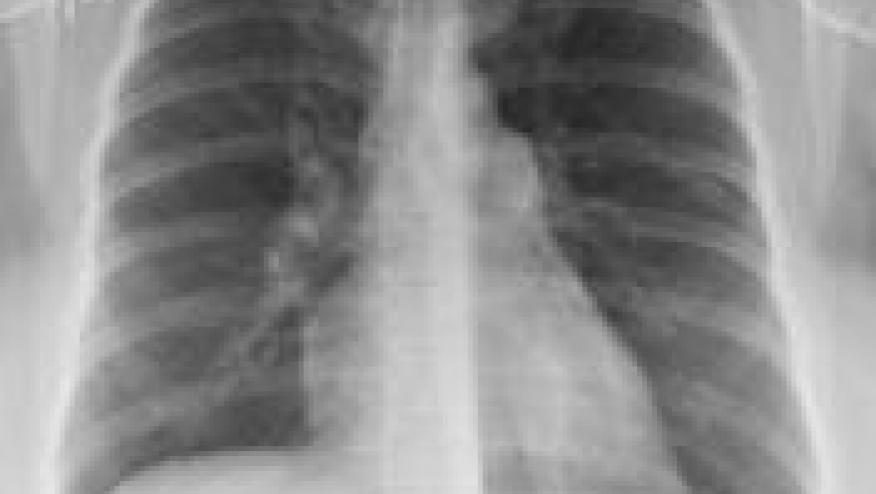Troponin and BNP in the Diagnosis of Pulmonary Hypertension Save

Common cardiac biomarkers could be used to identify patients with systemic sclerosis (SSc) at risk for developing pulmonary hypertension, French researchers reported.
On a multivariate analysis, increased levels of both high-sensitivity cardiac troponin T (HS-cTnT) and N-terminal probrain natriuretic peptide (NT-proBNP) among SSc patients were associated with a 50-fold increase in the risk for precapillary pulmonary hypertension (OR 50, 95% CI 1.6-580.4,P=0.026) compared with healthy controls, according to Jerome Avouac, MD, PhD, of Paris Descartes University, and colleagues.
In addition, normal concentrations of both markers had a high negative predictive value, at 92%, for pulmonary hypertension, the researchers reported in the July Arthritis Care & Research.
This negative predictive capacity "is noteworthy because normal levels of these two biomarkers may, in some cases, prevent immediate extensive and expensive investigations," they observed.
"These simple and widely available markers may be important for the diagnosis and the prognosis of pulmonary hypertension and thus need to be formally validated," they wrote.
HS-cTnT is a marker of damage to myocytes, and NT-proBNP is released by ventricular myocytes under conditions of strain. These biomarkers have demonstrated prognostic value in a variety of conditions, including myocardial infarction and heart failure.
HS-cTnT also is a prognostic factor in idiopathic pulmonary arterial hypertension, and some evidence has suggested that these markers might aid in the diagnosis of SSc-associated pulmonary hypertension, which is often a lethal complication of the connective tissue disease.
To examine more closely the relationship between plasma levels of the markers and SSc and also between the markers and disease features, Avouac and colleagues undertook a single-center, cross-sectional study that included 161 patients and 213 matched healthy controls at low cardiovascular risk.
Patients' mean age was 57, disease duration was 6 years, and 84% were women. A total of 60% had the limited cutaneous subtype of disease, while the other 40% had the diffuse cutaneous subtype. In 45%, there were no traditional cardiovascular risk factors such as high blood pressure, obesity, and diabetes.
HS-cTnT concentrations in the SSc patients ranged from 3 to 295 ng/L, compared with a range of 3 to 33 ng/L in the healthy controls, while concentrations of NT-proBNP ranged from 10 to 2,203 in patients compared with 2 to 612 ng/L in controls (P0.001 for both).
Even patients without any of the traditional cardiovascular risk factors had elevated levels, "suggesting that elevated levels of these markers may also reflect subclinical myocardial damage and dysfunction caused by the disease itself," the researchers noted.
When they looked at the relationship between HS-cTnT and SSc disease manifestations, they found that levels of the biomarker correlated with systolic pulmonary artery pressure (PAP) (r=0.20,P=0.032), and that median levels of the marker were higher in patients whose systolic PAP exceeded 40 mm Hg (P=0.029) or who had pulmonary hypertension confirmed by right heart catheterization (P=0.043).
Levels of HS-cTnT also were elevated in patients taking steroids for joint inflammation and in those with diffuse cutaneous disease.
On a multivariate analysis, the following were independently associated with levels of HS-cTnT above 14 ng/L:
- Diabetes, OR 11.2 (95% CI 1.4-91.8)
- Hypertension, OR 4.3 (95% CI 1.2-15.8)
- Precapillary pulmonary hypertension, OR 3.7 (95% CI 1.1-14.9)
- Diffuse cutaneous SSc subtype, OR 5.9 (95% CI 1.8-19.8)
Levels of NT-proBNP were higher in patients whose systolic PAP was above 40 mm Hg and who had pulmonary hypertension (P0.001 for both).
"Prospective studies with larger cohorts are now warranted to assess the merit of this combination of markers to predict the further occurrence of precapillary pulmonary hypertension," Avouac and colleagues concluded.
Limitations of the study included its observational design and the fact that most patients had not undergone cardiac magnetic resonance imaging.
This piece is brought to RheumNow readers by our friends at MedPage Today, where it originally appeared on June 30, 2015.










If you are a health practitioner, you may Login/Register to comment.
Due to the nature of these comment forums, only health practitioners are allowed to comment at this time.